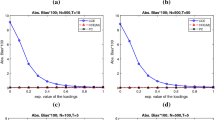Abstract
We consider a computationally simple orthogonal projection method to implement the (Bai and Ng in Econometrica 70:191–221, 2002) information criterion to select the factor dimension for panel interactive effects models that bypasses issues arising from the joint estimation of the slope coefficients and factor structure. Our simulations show that it performs well in cases the method can be implemented.
Similar content being viewed by others
Notes
Pesaran (2006) has proposed a common correlated effects (CCE) estimator for \( \varvec{\beta }\) that does not require the knowledge of the factor structure. However, the implementation of the CCE requires the data generating process of \({\mathbf {x}}_{it}\) to satisfy certain conditions such as:
$$\begin{aligned} {\mathbf {x}}_{it}=\varvec{\Xi }_{i}{\mathbf {f}}_{t}+\varvec{\varepsilon }_{it}, \end{aligned}$$(3.6)such that
$$\begin{aligned} {\mathbf {z}}_{it}&=\left( \begin{array}{c} y_{it} \\ {\mathbf {x}}_{it} \end{array} \right) =\left( \begin{array}{c} \varvec{\beta }^{\prime }\varvec{\Xi }_{i}+\varvec{\lambda }_{i}^{\prime } \\ \varvec{\Xi }_{i} \end{array} \right) {\mathbf {f}}_{t}+\left( \begin{array}{c} v_{it}+\varvec{\beta }^{\prime }\varvec{\varepsilon }_{it} \\ \varvec{\varepsilon }_{it} \end{array} \right) \nonumber \\&={\mathbf {C}}_{i}{\mathbf {f}}_{t}+\left( \begin{array}{c} v_{it}+\varvec{\beta }^{\prime }\varvec{\varepsilon }_{it} \\ \varvec{\varepsilon }_{it} \end{array} \right) , \end{aligned}$$(3.7)where
$$\begin{aligned} rank\left( {\mathbf {C}}_{i}\right) =p\text { and plim}_{N\rightarrow \infty } \frac{1}{N}\sum _{i=1}^{N}\varvec{\varepsilon }_{it}={\mathbf {0}}. \end{aligned}$$(3.3)Since not all the data generating processes of \({\mathbf {x}}_{it}\) satisfy these conditions, for instance, \({\mathbf {x}}_{it}\) could be orthogonal to \( {\mathbf {f}}_{t},\) in this paper, we consider identifying factor dimensions without imposing the Pesaran’s (2006) conditions on \({\mathbf {x}}_{it}.\)
It should be noted that the properties of the projection matrix, \({\mathbf {M}} _{T}\) is invariant to the choice of \(\left( {{\tilde{\mathbf{X}}}}^{\prime } {{\tilde{\mathbf{X}}}}\right) ^{-}\) [e.g., Rao and Toutenburg (1999, p. 374)].
Additional simulation results for model with 5 factors are available upon request.
For one replication of Case 1 when \(N=1000,T=40,\) the CPU time for the ABC approach is 12.11 seconds and 83.55 seconds for the orthogonal projection method and recursively iterating method with the maximum number of iteration equals 10, respectively. The computer running these codes is a Dell Precision Tower 7910 with two Intel Xeon E5-2698v4 CPUs and 64 Gb RAM based on Matlab R2019b.
The data can be downloaded from the data archive of the Journal of Applied Econometrics at http://qed.econ.queensu.ca/jae/2013-v28.6/.
References
Alessi L, Barigozzi M, Capasso M (2010) Improved penalization for determining the number of factors in approximate factor models. Stat Probab Lett 80:1806–1813
Bai J (2009a) Panel data models with interactive fixed effects. Econometrica 77:1229–1279
Bai J (2009b) Supplement to panel data models with interactive fixed effects: technical details and proofs. Econometrica 77:1229–1279
Bai J, Ng S (2002) Determining the number of factors in approximate factor models. Econometrica 70:191–221
Bloom N, Schankerman M, Van Reenen J (2013) Identifying technology spillovers and product market rivalry. Econometrica 81:1347–1393
Burda M, Harding M (2013) Panel probit with flexible correlated effects: quantifying technology spillovers in the presence of latent heterogeneity. J Appl Economet 28:956–981
Hsiao C (2014) Analysis of panel data. Cambridge Univ. Press, Cambridge
Hsiao C (2018) Panel models with interactive effects. J Economet 206:645–673
Hsiao C, Zhou Q (2019) Panel parametric, semiparametric, and nonparametric construction of counterfactuals. J Appl Economet 34:463–481
Jiang B, Yang Y, Gao J, Hsiao C (2020) Recursive estimation in large panel data models: theory and practice. J Economet (forthcoming)
Lu X, Su L (2016) Shrinkage estimation of dynamic panel data models with interactive fixed effects. J Economet 190:148–175
Moon R, Weidner M (2015) Linear regression for panel with unknown number of factors as interactive fixed effects. Econometrica 83:1543–1579
Moon R, Weidner M (2017) Dynamic linear panel regression models with interactive fixed effects. Economet Theory 33:158–195
Moon R, Weidner M (2018) Nuclear norm regularized estimation of panel regression models, working paper
Pesaran MH (2006) Estimation and inference in large heterogeneous panels with a multifactor error structure. Econometrica 74:967–1012
Rao CR, Toutenburg H (1999) Linear models: least squares and alternatives, 2nd edn. Springer, New York
Xu Y (2017) Generalized synthetic control method: causal inference with interactive fixed effects model. Polit Anal 25:57–76
Yanai H, Takeuchi K, Takane Y (2011) Projection matrices, generalized inverse matrices, and singular value decomposition. Springer, Berlin
Author information
Authors and Affiliations
Corresponding author
Additional information
Publisher's Note
Springer Nature remains neutral with regard to jurisdictional claims in published maps and institutional affiliations.
We wish to thank the editor, an associate editor and two anonymous referees for very helpful comments. Research support by China NSF #71631004 and #72033008 to Cheng Hsiao is gratefully acknowledged.
Supplementary Information
Below is the link to the electronic supplementary material.
Rights and permissions
About this article
Cite this article
Hsiao, C., Xie, Y. & Zhou, Q. Factor dimension determination for panel interactive effects models: an orthogonal projection approach. Comput Stat 36, 1481–1497 (2021). https://doi.org/10.1007/s00180-020-01059-y
Received:
Accepted:
Published:
Issue Date:
DOI: https://doi.org/10.1007/s00180-020-01059-y



